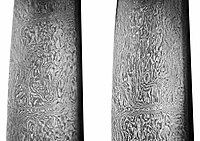
Photo from wikipedia
Abstract The carbon is one of the basic alloying solutes in steels. In the present study, the newly carbon microalloyed X80 steel was designed for the next generation of pipeline… Click to show full abstract
Abstract The carbon is one of the basic alloying solutes in steels. In the present study, the newly carbon microalloyed X80 steel was designed for the next generation of pipeline and the carbon microalloying effect of base material on the crystallographic structure of coarse grained heat affected zone (CGHAZ) of X80 girth welded joints was systematically investigated using electron back-scattering diffraction (EBSD), considering the fact that crystallography is the most intrinsic aspect in evaluating the microstructure. The results indicated a remarkable variation in the density of high angle grain boundaries and their dispersion by increasing the carbon content of 0.03wt%. It was attributed to the differential shearing mechanism, which was primarily sheared by variant pairing of V1/V2 at 0.06 wt% carbon, whereas at lower 0.03wt% carbon, V1/V4 pairing mechanism dominated the transformation. The preferential variant pairing transformation mechanism at differential carbon content therefore generated dissimilarly selected variants. Thus, as the carbon content increased, the variant selection effect upon phase transformation was attenuated by generating more variants from different Bain groups. The variant pair V1/V2 belonging to different Bain groups neighboring in CGHAZ of high carbon steel increased the density of high angle boundary (Σ3 boundary). Moreover, the variation in CTOD (crack-tip opening displacement) property of HAZ suggested that it should be primarily correlated to the block size (or density of block boundaries) of CGHAZ.
Journal Title: Materials Characterization
Year Published: 2019
Link to full text (if available)
Share on Social Media: Sign Up to like & get
recommendations!